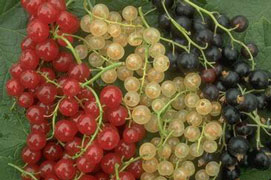


Home
Flowers &
Indoor Plants
Fruits & Nuts
Ornamentals
Vegetables
Special Topics
Resources
Glossary

 |
What about it? There are many varieties of currants including red, white, black, and flowering. The currant may have arrived in North America with the first settlers. The 'Red Dutch' and 'White Dutch' cultivars were the first to arrive in the New World. The plant is an attractive, bush-like group of canes that grows to about 3-4 feet. Currants resemble a dried grape once produced in Corinth; the name evolved as "Corinths" became "currants". What is it used for? Black currants are often used in brandies, syrups and confections. They are not grown in New York, since they are the alternate host for a disease called white pine blister rust. The fruit of white currants is used commercially for baby food. Red currants are grown for their juice and for use in preserves. They make a beautiful clear, red jelly. Where does it grow? How do we grow it? Currants are very hardy and can be grown in areas with very cold winter temperatures. They are one of the few fruit crops that will tolerate partial shade. Sites with good air drainage are preferable. Currants require well-drained soils. Plant red currants 3 to 4 feet apart in rows, or place them in the landscape and enjoy them for their ornamental qualities. What are its primary problems? Common diseases of currants include cane blight, rust, powdery mildew, leaf spot, and root rot. Common insects include the San Jose scale, currant borer, and black currant gall mite. How do we harvest and store it? The berries on a currant bush ripen over a 2-week period. Once a berry ripens, you can usually get away with leaving it on the bush a week or more without dropping or becoming overmature. Currants for jelly are picked slightly underripe. You can pick whole clusters and strip the berries from the stems later. Currants do not store well because they will mold easily, especially if berries are broken.
© Copyright, Department of Horticulture, Cornell University. |




